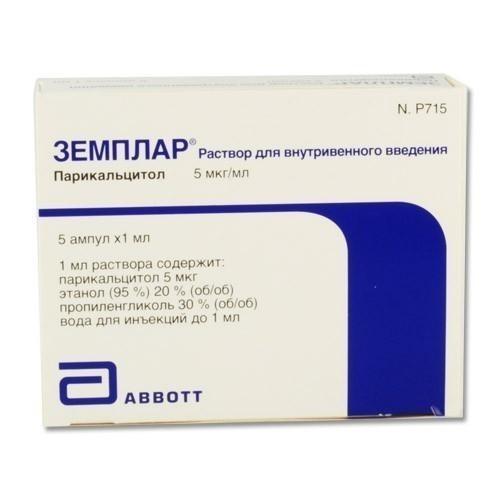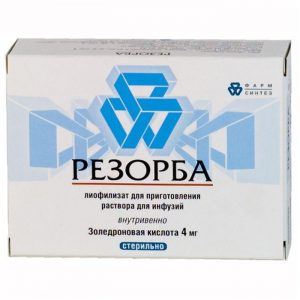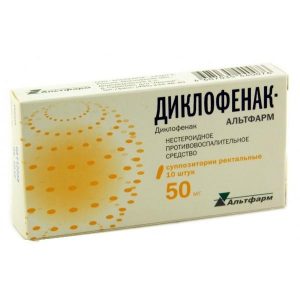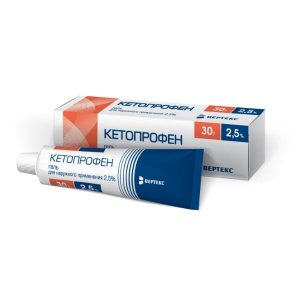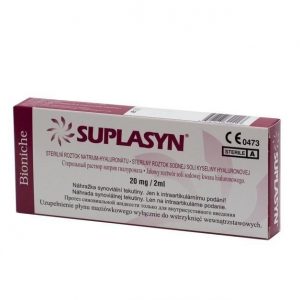Description
Latin name
ZEMPLAR
Release form
Solution for iv administration.
Packaging
In an ampoule of 5 ml of solution. In a cardboard package 5 ampoules.
Pharmacological action
Pharmacodynamics
A drug that regulates the exchange of calcium and phosphorus. Paricalcitol is a synthetic analogue of biologically active vitamin D (calcitriol). Paricalcitol has a biological effect by interacting with vitamin D receptors, leading to selective activation of the response mediated by this vitamin. Vitamin D and paricalcitol reduce the level of parathyroid hormone by inhibiting its synthesis and secretion. In the early stages of chronic kidney disease, calcitriol levels decrease.
Secondary hyperparathyroidism is characterized by an increase in the content of parathyroid hormone (PTH), which is associated with an inadequate level of active vitamin D. This vitamin is synthesized in the skin and enters the body with food. Vitamin D sequentially hydroxylates in the liver and kidneys and turns into an active form that interacts with vitamin D. receptors.
Calcitriol [1.25 (OH) 2 D3] is an endogenous hormone that activates vitamin D receptors in the parathyroid glands, intestines, kidneys and bone tissue (due to this it supports the function of the parathyroid glands and homeostasis of calcium and phosphorus), as well as in many other tissues, including the prostate gland, endothelium and immune cells. Activation of receptors is necessary for normal bone formation. In kidney diseases, the activation of vitamin D is suppressed, which leads to an increase in the level of PTH, the development of secondary hyperparathyroidism and disruption of calcium and phosphorus homeostasis. A decrease in calcitriol levels and an increase in PTH activity, which often precede changes in plasma levels of calcium and phosphorus, cause changes in the rate of bone metabolism and can lead to the development of renal osteodystrophy. In patients with chronic kidney disease, a decrease in the level of PTH has a beneficial effect on the activity of bone alkaline phosphatase, metabolic processes in bone tissue and bone fibrosis. Active vitamin D therapy not only reduces the level of PTH and improves metabolic processes in bone tissue, but also helps to prevent or eliminate other consequences of vitamin D deficiency.
Pharmacokinetics
Within two hours after iv bolus administration of paricalcitol in doses of 0.04 mcg / kg to 0.24 μg / kg, the concentration of the drug decreases rapidly, however, subsequently, the concentration of the drug decreases linearly, with an average T1 / 2 of about 15 hours. With repeated use of paricalcitol, no cumulation is observed.
Distribution of
Paricalcitol is actively bound to plasma proteins (more than 99%). In healthy people, Vd in equilibrium is about 23.8 liters. In patients with chronic kidney disease stage 5, treated with hemodialysis or peritoneal dialysis, Vd paricalcitol at a dose of 0.24 μg / kg averages 31-35 liters. The pharmacokinetics of paricalcitol was studied in patients with chronic renal failure receiving hemodialysis treatment.
Metabolism
Several metabolites of the drug are detected in urine and feces. In urine, unchanged paricalcitol was not detected. Paricalcitol is metabolized by hepatic and nonhepatic enzymes, including mitochondrial CYP24, as well as CYP3A4 and UGT1A4. Identified metabolites include 24 (R) -hydroxylation products (in plasma at low concentrations), as well as 24.26- and 24.28-dihydroxylation and direct glucuronidation. Paricalcitol does not inhibit CYP1A2, CYP2A6, CYP2B6, CYP2C8, CYP2C9, CYP2C19, CYP2D6, CYP2E1 or CYP3A at concentrations up to 50 nM (21 ng / ml). At similar concentrations of paricalcitol, the activity of CYP2B6, CYP2C9 and CYP3A4 increases by less than 2 times.
Excretion
Paricalcitol is excreted by excretion with bile. In healthy people, approximately 63% of the drug is excreted through the intestines and 19% by the kidneys. T1 / 2 of paricalcitol when used in doses from 0.04 to 0.16 mcg / kg in healthy volunteers averages 5-7 hours.
Pharmacokinetics in special clinical cases
The pharmacokinetics of paricalcitol in people over the age of 65 has not been studied.
The pharmacokinetics of paricalcitol in children and adolescents under the age of 18 has not been studied. The pharmacokinetics of paricalcitol does not depend on gender.
Pharmacokinetics of paricalcitol (0, 24 μg / kg) were compared in patients with mild to moderate impaired liver function (according to the Child-Pugh classification) and healthy people.
The pharmacokinetics of unbound paricalcitol were similar in these patient groups. Dose adjustment in patients with mild or moderate impaired liver function is not required. The pharmacokinetics of paricalcitol in patients with severe hepatic impairment has not been studied.
The pharmacokinetics of paricalcitol was studied in patients with stage 5 chronic kidney disease treated with hemodialysis or peritoneal dialysis. Hemodialysis did not significantly affect the excretion of paricalcitol. However, in patients with chronic kidney disease of stage 5, a decrease in clearance and an increase in T1 / 2 were revealed in comparison with healthy people.
Indications
Prevention and treatment of secondary hyperparathyroidism developing in chronic renal failure (chronic kidney disease stage 5).
Contraindications
Hypervitaminosis D
co-administration with phosphates or derivatives of vitamin D
hypercalcemia
children under 18 years of age (no clinical studies)
breastfeeding period
hypersensitivity to the component.
Caution: the drug should be prescribed simultaneously with cardiac glycosides.
Use during pregnancy and lactation
Studies in pregnant women have not been conducted. There is no information on the excretion of paricalcitol with breast milk in women. Paricalcitol can be used during pregnancy only if the potential benefit to the mother justifies the possible risk to the fetus. If necessary, use the drug during lactation, breastfeeding should be discontinued.
Composition
1 ml of solution contains:
Active substances: paricalcitol 5 mcg.
Excipients: ethanol 95%, propylene glycol, water d / i.
Dosage and Administration
Zemplar ® is usually administered iv through a hemodialysis catheter. If the patient does not have a hemodialysis catheter, then the drug can be entered slowly in / in for at least 30 seconds to minimize pain during infusion. Like other solutions for parenteral use, the ampoule with Zemplar ® should be inspected before administration for foreign particles and discoloration. Unused solution residues should be poured.
Adults
Initial dose of
There are two methods for selecting the initial dose of paricalcitol. In clinical studies, the maximum safe dose reached 40 mcg.
Selection of the initial dose by body weight
The recommended initial dose of paricalcitol is 0.04-0.1 mcg / kg (2.8-7 mcg). It is administered as a bolus no more than every other day during dialysis. The choice of the initial dose taking into account the initial level of PTH In patients with chronic renal failure (chronic kidney disease stage 5), the second generation method is used to analyze the level of biological active intact PTH. The initial dose is calculated according to the formula below and is administered iv in the form of a bolus no more often than every other day during dialysis:
Initial dose (μg) = Initial PTH level (pg / ml) / 80.
Dose titration
The generally accepted target levels of PTH in patients with end-stage renal failure receiving dialysis treatment are no more than 1.5-3 times higher than VGN in patients without uremia (150-300 pg / ml). To achieve these levels, careful monitoring of PTH levels and individual dose titration are necessary.
With any dose changes, serum levels of calcium (adjusted for hypoalbuminemia) and phosphorus should be determined more often. With an increase in the adjusted level of calcium (> 11.2 mg / dl) or a persistent increase in the concentration of phosphorus (> 6.5 mg / dl), it is necessary to reduce the dose of the drug until these indicators are normalized. In the presence of hypercalcemia or a persistent increase in the Ca product? P (more than 75) should reduce the dose of the drug or take a break in treatment until these parameters are normalized. Then, paricalcitol therapy can be resumed in a lower dose. If the patient receives a calcium-containing drug that binds phosphates, then it is advisable to reduce his dose, temporarily cancel the drug or transfer the patient to a drug that does not contain calcium. As PTH levels decrease in response to treatment, a dose reduction of paricalcitol may be required. Thus, the dose should be selected individually.
If an adequate response fails, the dose can be increased by 2-4 mcg every 2-4 weeks. With a decrease in PTH level <150 pg / ml, the dose should be reduced. Recommended dose titration scheme PTH level Dose of paricalcitol Same or increasing Increase by 2-4 μg Decrease by <30% Increase by 2-4 μg Decreased by> 30%, but <60% srd dose Decreased by> 60%
Decrease by 2-4 mcg
<150 (1 pg / ml) Decrease by 2-4 mcg 1.5-3 times higher VGN (150-300 pg / ml) Not change the dose of Side effects Frequency of unwanted clinical trials in phases 2 and 3. The table lists the adverse events of any genesis, the frequency of which in the paricalcalcitol group was 2% or more (patients in whom the same reaction was recorded repeatedly was taken into account 1 time). Frequency of adverse events in all placebo-controlled studies Adverse events Paricalcitol (n = 62) Placebo (n = 51) General Chills 5% 2% srdlrd kpk 3% of the week 2% Influenza 5% 4% Sepsis 5% 2% Cardiovascular Heart palpitations 3% srdlrd 2% srdlrd 3% srdlrd -intestinal bleeding 5% 2% Nausea 13% 8% Vomiting 8% 6% From the central nervous system Golovokr constriction 5% 2% From the respiratory system Pneumonia 5% 0 Other Edema 7% 0 Changes average levels of calcium, phosphorus, Ca products P in an open 13-month study confirms the safety of long-term paricalcitol therapy in this group of patients. Adverse events in a 4-phase clinical trial In one 4-phase study, headache (2%) and taste perversion (2%) were often noted. Adverse reactions reported in post-marketing observations In clinical practice, the following adverse reactions have rarely been reported with injectable paricalcitol: Allergic reactions: urticaria, Quincke’s edema, laryngeal edema. From the peripheral nervous system: taste perversion (metallic taste). Dermatological reactions: rash, itching. Drug Interaction According to in vitro studies, paricalcitol should not inhibit the clearance of CYP1A2, CYP2, CYP2, CYP, or CYP2C6, CYP2, CYP2, or CYP2C9. , CYP2C9 or CYP3A. The interaction of paricalcitol for injection with other drugs has not been specifically studied. When studying the interaction of ketoconazole and parical calcitol in capsules, it was shown that ketoconazole causes an increase in the AUC of parical calcitol about 2-fold. Paricalcitol is partially metabolised by the CYP3A isoenzyme, and ketoconazole is a potent inhibitor of this isoenzyme, so caution should be exercised when co-administering paricalcitol with ketoconazole and other potent CYP3A isoenzyme inhibitors. Hypercalcemia of any genesis enhances cardiac glycoside intoxication, so caution should be exercised when combined with parical calcitol. Overdose Symptoms: Overdosage of paricalcitol may lead to the development of hypercalcemia, hypercalciuria, hyperphosphatemia, and suppression of PTH secretion. Acute overdose of paricalcitol can lead to the development of hypercalcemia and requires immediate help. Serum calcium and phosphorus levels should be monitored regularly during dose selection. Long-term therapy with parical calcitol can be complicated by hypercalcemia, an increase in Ca P and soft tissue calcification (metastatic calcification). Treatment: In clinically significant hypercalcaemia, the dose of paricalcitol should be reduced immediately or treatment interrupted. Recommended measures include a hypocalcemic diet, withdrawal of calcium, control of water-electrolyte balance, evaluation of ECG changes (critical for patients receiving cardiac glycosides), and hemodialysis or peritoneal dialysis using calcium-free dialysis. Serum calcium levels should be monitored regularly prior to normalization. When suppression of PTH is below normal, the development of adynamic bone disease, a pathological condition with low bone turnover, is possible. Storage conditions Keep out of the reach of children at a temperature of 15 ° to 25 ° C. Do not freeze. Expiration 2 years. Deystvuyuschee substances Parykaltsytol pharmacy terms and conditions for prescription dosage form dosage form infusion solution
